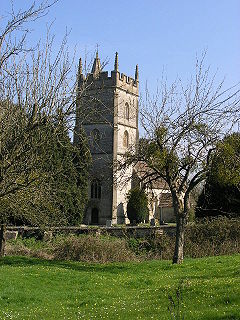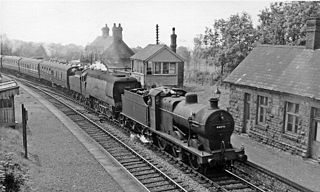Related Research Articles

The West Somerset Railway (WSR) is a 22.75-mile (36.6 km) heritage railway line in Somerset, England. The freehold of the line and stations is owned by Somerset County Council; the railway is leased to and operated by West Somerset Railway plc ; which is supported and minority-owned by charitable trust the West Somerset Railway Association (WSRA) and the West Somerset Steam Railway Trust (WSSRT). The WSR plc operates services using both heritage steam and diesel trains.

The Avon Valley Railway (AVR) is a three-mile-long heritage railway based at Bitton station in South Gloucestershire, England, between Bristol and Bath and is operated by a local group: The Avon Valley Railway Company Ltd. The railway follows the Avon Valley south-east from Oldland Common, through Bitton and alongside the River Avon towards Kelston and Bath. The railway shares its route with the Sustrans cycleway and footpath, the Bristol and Bath Railway Path.

The Somerset and Dorset Joint Railway, also known as the S&D, SDJR or S&DJR, was an English railway line connecting Bath and Bournemouth, with a branch from Evercreech Junction to Burnham-on-Sea and Bridgwater. Strictly speaking, the main line ran from Bath Junction to Broadstone, as the line between Broadstone and Bournemouth was owned by the London and South Western Railway, while the line between Bath Junction and Bath was owned by the Midland Railway.

The Somerset & Dorset Railway Heritage Trust (S&DRHT) is a heritage railway line in Somerset, England, that runs on a restored section of the Somerset and Dorset Joint Railway. The line is approximately 1 mile long and operates from Midsomer Norton South.

Combe Down Tunnel is on the now-closed Somerset and Dorset Joint Railway main line, between Midford and Bath Green Park railway station, below high ground and the southern suburbs of Bath, England, emerging below the southern slopes of Combe Down village.

Midford railway station was a single-platform station on the Bath extension of the Somerset and Dorset Railway, just to the north of the point where the double-track became a single track. It served the village of Midford. The station was closed with the rest of the line in March 1966 under the Beeching axe, though it had been unstaffed for some years before that.

Edington Burtle railway station was a station on the Somerset and Dorset Joint Railway, and served the village of Edington, Somerset, UK. Originally named Edington Road, with the village two miles away, it became in 1890 the junction for the Bridgwater branch off the Highbridge line and for the next period in its life was known as Edington Junction. After the Bridgwater line closed to passengers in 1952, the station was renamed as Edington Burtle – Burtle is a village to the north of the station, and somewhat closer than Edington. In February 1956 the down platform and signal box was closed. Goods Yard closed on 13 July 1964. It closed in March 1966 when the line was shut as part of the Beeching axe.

Chilcompton railway station was a station on the Somerset and Dorset Joint Railway at Chilcompton in the county of Somerset in England and opened on 20 July 1874. Originally the station consisted of a single platform on the Down side with a station building and possibly also a siding. In 1876 a loop and second platform were opened on the Up side, controlled from a 16-lever signal-box on the Down platform, which also controlled access to the goods yard. The line to Binegar was doubled in 1885. In 1886 the line to Midsomer Norton and Radstock was doubled and a replacement 13 lever signal box provided just beyond the Binegar end of the Up platform. The station closed to goods in 1964 and the signal-box closed in 1965; passenger services were withdrawn when the SDJR closed on 7 March 1966.

Pylle is a village and civil parish 4 miles (6.4 km) south west of Shepton Mallet, and 7 miles (11.3 km) from Wells, in the Mendip district of Somerset, England. It has a population of 160. The parish includes the hamlet of Street on the Fosse.
There are 22 disused railway stations in the 75 miles (121 km) between Bristol Temple Meads and Exeter St Davids, 12 of which have structures that can still be seen from passing trains. Most were closed in the 1960s but four of them, especially around Weston-super-Mare, were replaced by stations on new sites. 13 stations remain open on the line today, but there have been proposals to reopen stations at Cullompton and Wellington.

Masbury railway station was a small isolated station on the Somerset and Dorset Joint Railway's main line between Evercreech Junction and Bath. It was situated to the north of Shepton Mallet and near the summit of the line as it crossed the Mendip Hills. The station opened in 1874 and closed with the rest of the line under the Beeching Axe in March 1966.

Shillingstone railway station was a station on the Somerset and Dorset Joint Railway (S&DJR), serving the village of Shillingstone in the English county of Dorset. Shillingstone is the last surviving example of a station built by the Dorset Central Railway.
West Pennard railway station was a station on the Highbridge branch of the Somerset and Dorset Joint Railway. Opened on 3 February 1862, it was reduced to halt status on 25 June 1962. Originally the S&DJR main line, the railway was reduced to branch status when the extension to Bath was built. A passing point on the single line, the station was adjacent to a level crossing on the A361 road from Shepton Mallet to Glastonbury. The station closed with the railway on 7 March 1966.

Glastonbury and Street railway station was the biggest station on the original Somerset and Dorset Joint Railway main line from Highbridge to Evercreech Junction until closed in 1966 under the Beeching axe. It was the junction for the short branch line to Wells which closed in 1951.

Polsham was a railway station on the Somerset and Dorset Railway in the village of Polsham, Somerset in England.

Wells was a railway station on the Somerset and Dorset Joint Railway at Wells in the county of Somerset in England. Opening on 15 March 1859 as Wells, on the Somerset Central Railway, at that time a broad-gauge line operated by the Bristol and Exeter Railway, prior to that company's amalgamation with the Dorset Central Railway to form the Somerset & Dorset, it was the terminus of the branch from Glastonbury.

Ashcott railway station was a station on the Highbridge branch of the Somerset and Dorset Joint Railway. Opened by the Somerset Central Railway in 1856 as Ashcott and Meare, the name changed to Ashcott in 1876. Consisting of a short wooden platform and station building, the station was next to a road level crossing. This was operated with a 10 lever ground frame.

Shapwick station was a railway station on the Highbridge branch of the Somerset and Dorset Joint Railway. Opened by the Somerset Central Railway in 1854, the station consisted of a goods yard, a passing loop with two platforms, and a wooden station building which burned down and was replaced in 1900.
Bawdrip Halt was a railway station at Bawdrip on the Bridgwater branch of the Somerset and Dorset Joint Railway.
The Yeovil–Taunton line was a railway line in England, built by the Bristol and Exeter Railway (B&ER) to connect its main line with the market town of Yeovil in Somerset. It opened in 1853 using the broad gauge of 7 ft 1⁄4 in and was the first railway to serve Yeovil. It ran from a junction at Durston although in later years passenger trains on the line ran through to and from Taunton where better main and branch line connections could be made.